3-4. Inspection by sampling
summary of each distress and severity level(s) of
a. General. Inspection of every sample unit in a
distress contained in the sample unit. These data are
pavement section may be necessary if exact quantities
used to compute the PCI for the sample unit as outlined
are needed for contracting; however, such inspections
in paragraph 3-5. Figure 3-2 is an example of DA Form require considerable effort, especially if the section is
5145-R showing the summary of distresses for the
large. Because of the time and effort involved, frequent
sample unit.
surveys of an entire section subjected to heavy traffic
volume may be beyond available manpower, funds, and
c. Inspection procedures for asphalt, tar-surfaced,
time. Therefore, sampling plans have been developed to
and/or asphalt over concrete pavement. As with jointed
allow adequate determination of the PCI and M&R
concrete pavements, the pavement section must first be
requirements by inspecting only a portion of the sample
divided into sample units. During either the entire
units in a pavement section. The sampling plans can
section inspection or inspection by sampling, the
reduce inspection time considerably and still provide the
inspector walks over each sample unit, measures each
accuracy required. The number and location of sample
distress type and severity, and records the data on the
units to be inspected is dependent on the purpose of
DA Form 5146-R, Asphalt Pavement Inspection Sheet
inspection. If the purpose is to determine the overall
(fig E-2).
condition of the pavement in the network (e.g., initial
(1)
The equipment needed is a hand
inspection to identify projects, budget needs, etc.), then a
odometer used to measure distress lengths and areas, a
survey of one or two sample units per section may
10-foot straightedge, and a ruler to measure the depth of
suffice. The units should be selected to be
ruts or depressions.
representative of the overall condition of the section. If
(2)
One form is used for each sample unit.
the purpose, however, is to analyze various M&R
One column on the form is used to represent each
alternatives for a given pavement section (e.g., project
identified distress type. The number of that distress type
design, etc.), then more sampling should be performed.
is indicated at the top of the column. Amount and
The following paragraphs present the sampling
severity of each distress identified is listed in the
procedure for this purpose.
appropriate column. An example of a completed DA
b. Determining the number of samples.
Form 5146-R Asphalt Pavement Inspection Sheet is
(1)
The first step in performing inspection by
shown at figure 3-3. Distress No. 6 (depression) is sampling is to determine the minimum number of sample
recorded as 6x4L, which indicates that the depression is
units (n) that must be surveyed. This is done by using
a 6-foot by 4=foot area and of low severity. Distress No.
figure 3-4.
10 (longitudinal and transverse cracking) is measured in
linear feet; 3-2 thus, 10L indicates 10 linear feet of light
cracking, etc. The total distress data are used to
3-2
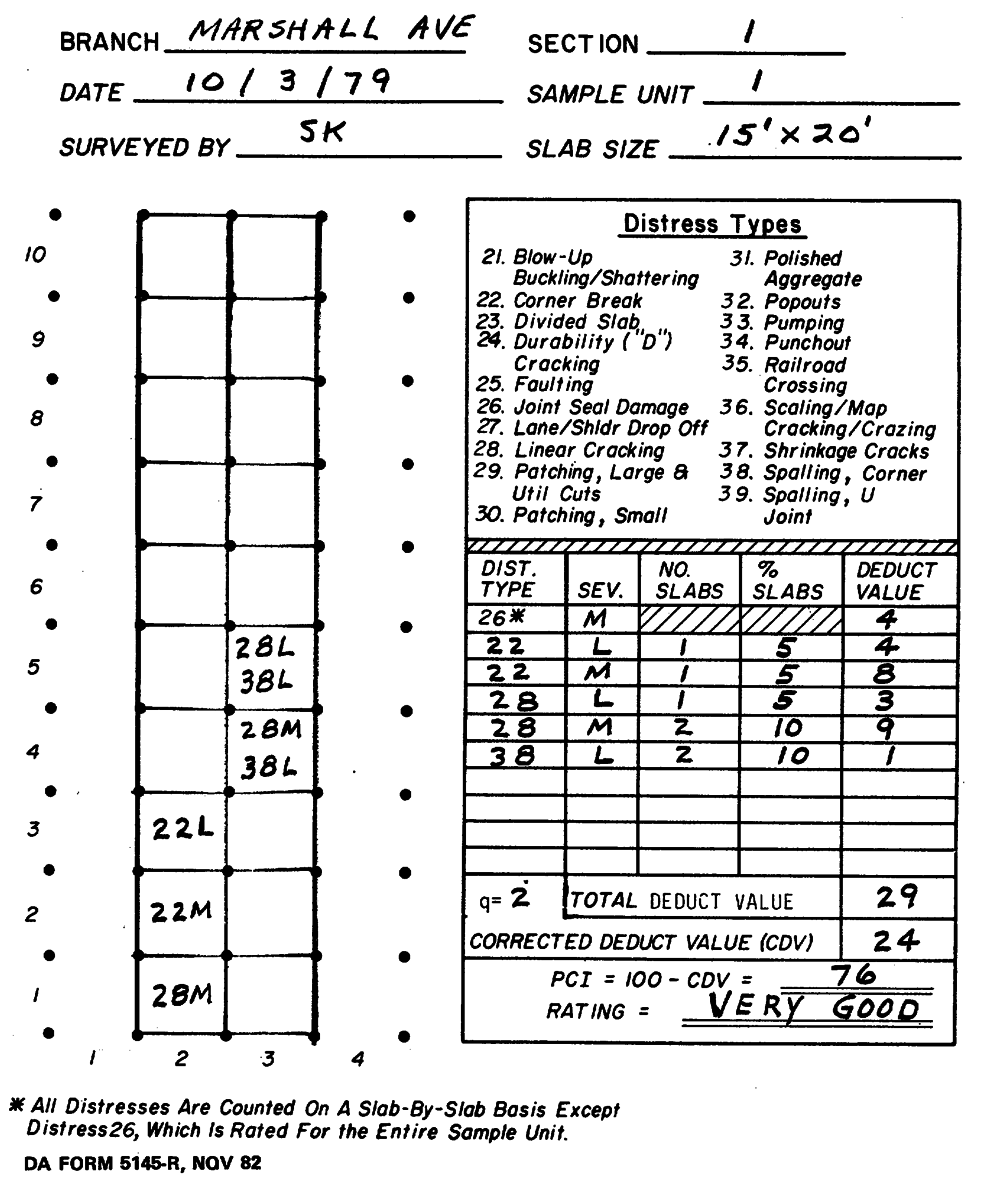
TM 5-623
CONCRETE PAVEMENT INSPECTION SHEET
For use of is form, see TM 5-623; the proponent agency is USACE.
Figure 3-2. An example of a completed DA Form 5145-R, Concrete Pavement Inspection Sheet.
3-3
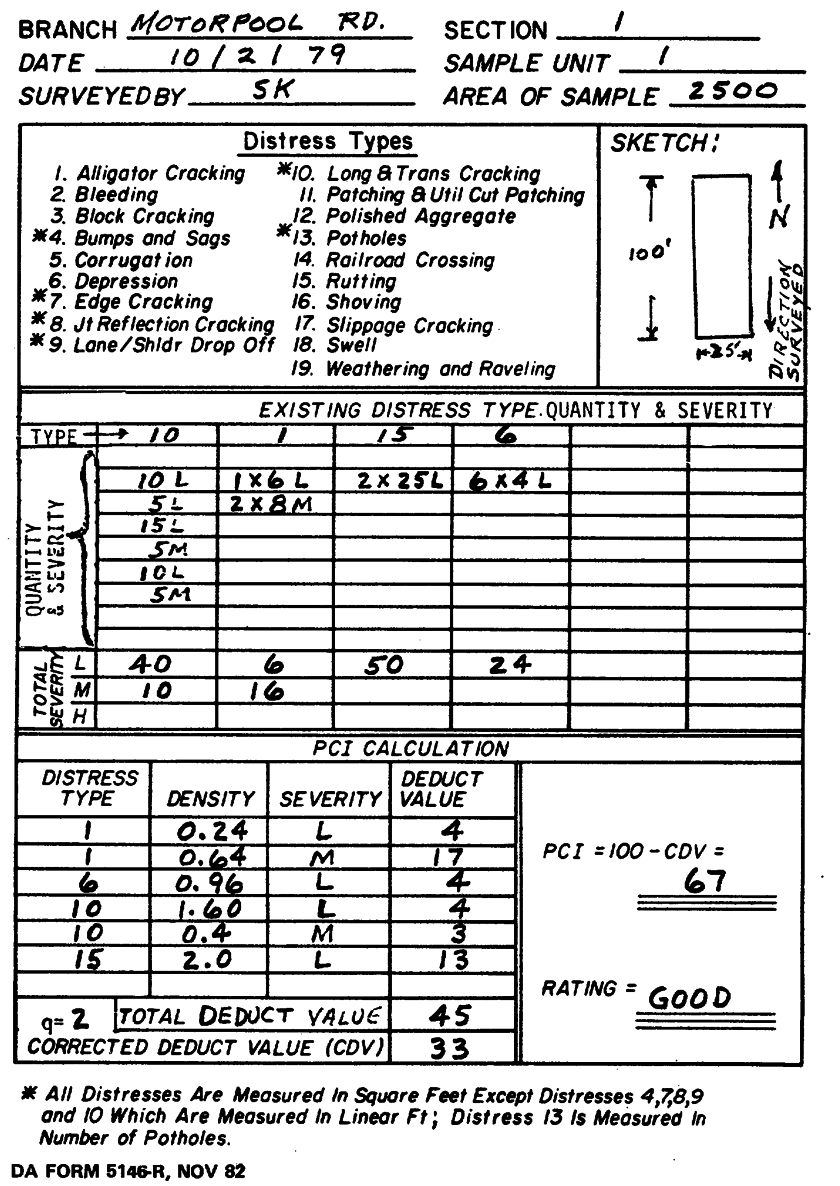
TM 5-623
ASPHALT PAVEMENT INSPECTION SHEET
For use of this form, see TM 5-623; the proponent agency is USACE.
Figure 3-3. An example of a completed DA Form 5146-R, Asphalt Pavement Inspection Sheet.
3-4
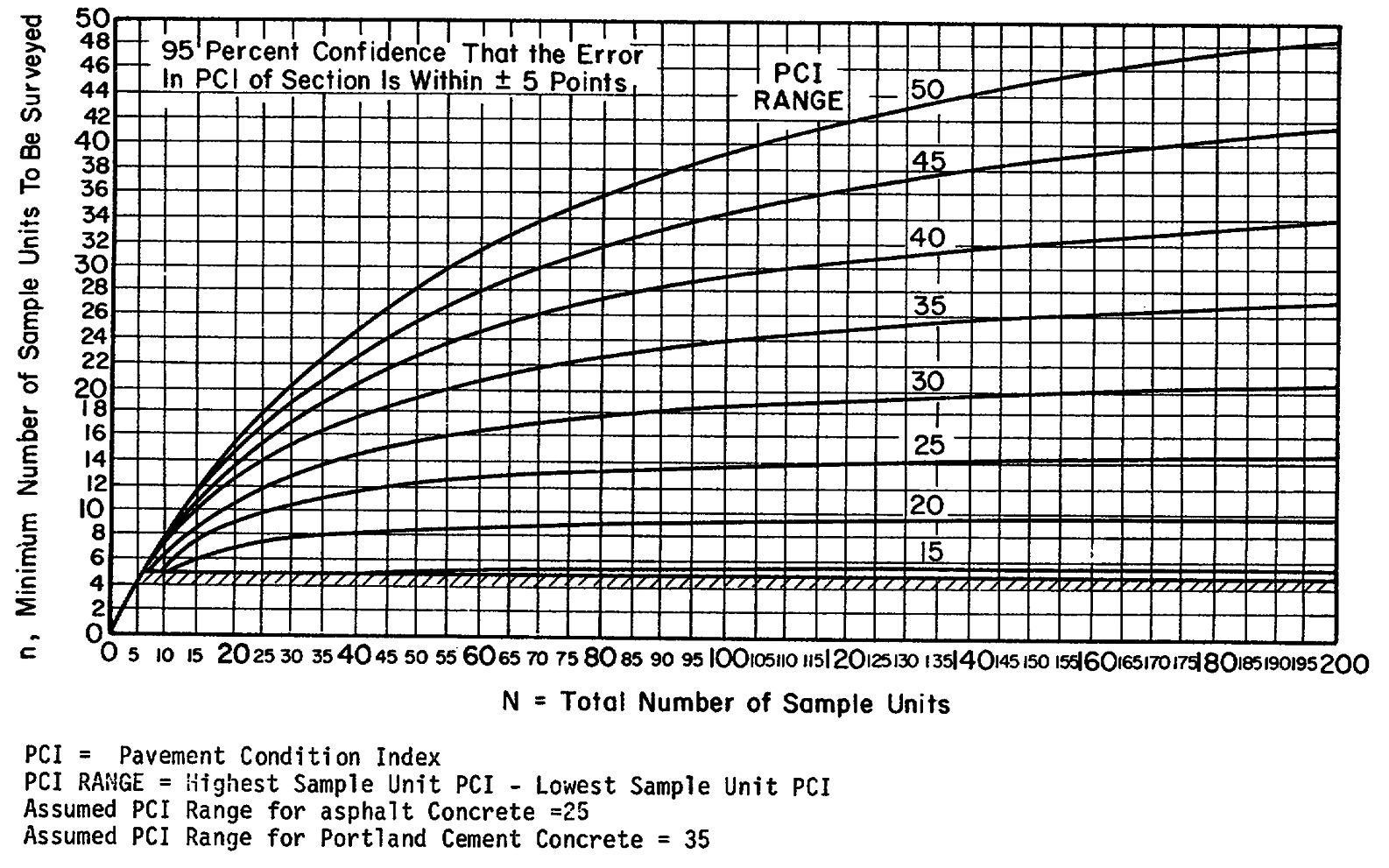
TM 5-623
(2)
The curves shown in figure 3-4 are used
sampling is complete. However, if the PCI range of the
to select the minimum number of sample units that must
samples taken was found to be 40, it would be
be inspected. This will provide a reasonable estimate of
necessary to go back to figure 34. Start at 20 on the N
the true mean PCI of the section. The estimate is within
scale again, proceed vertically to the curve PCI
plus or minus 5 points of the true mean PCI about 95
range=40, and read 13 on the n scale. In this unusual
percent of the time. When performing the initial
case it would be necessary to survey the additional 4
inspection, the PCI range for a pavement section (i.e.,
samples (9+4 = 13).
lowest sample unit PCI subtracted from the highest
sample unit PCI) is assumed to be 25 for asphalt
(b) Given: Portland cement concrete
concrete (AC) surfaced pavements and 35 for Portland
pavement section with N=30. Find: n.
cement concrete (PCC) surfaced pavements. For
Answer: Start at 30 on the N scale, proceed vertical to
subsequent inspections, the actual PCI range
appropriate curve (PCI range=35) and read 15 on the n
(determined from the previous inspection) is used to
scale.
determine the minimum number of sample units to be
surveyed. As illustrated in figure 3-4, when the total (c) Given: An AC or PCC pavement
number of samples within the section is less than five,
section with N<5. Find: n.
every sample unit should be surveyed. If N is greater
Answer: Survey all sample units.
than five, at least five sample units should be surveyed.
(3)
Examples of first assumption for number
c. Selection of samples. Determining specific
of sample units to be surveyed n follow:
sample units to inspect is as important as determining
(a) Given: Asphalt concrete pavement
the minimum number of samples (n) to be surveyed.
section with total number of sample units, N=20.
The recommended method for selecting the samples is
Find: n.
to choose samples that are equally spaced; however, the
first sample should be selected at random. This
Answer: Start at 20 on the N scale (fig 3-4), proceed technique, known as systematic sampling, is illustrated in
vertically to the appropriate curve (PCI range= 25) and
figure 3-5 and is briefly described below.
read 9 on the n scale. Nine sample units should be
surveyed. If the PCI range is found to be within 25 the
Figure 3-4. Determination of minimum number of sample units to be surveyed.
3-5
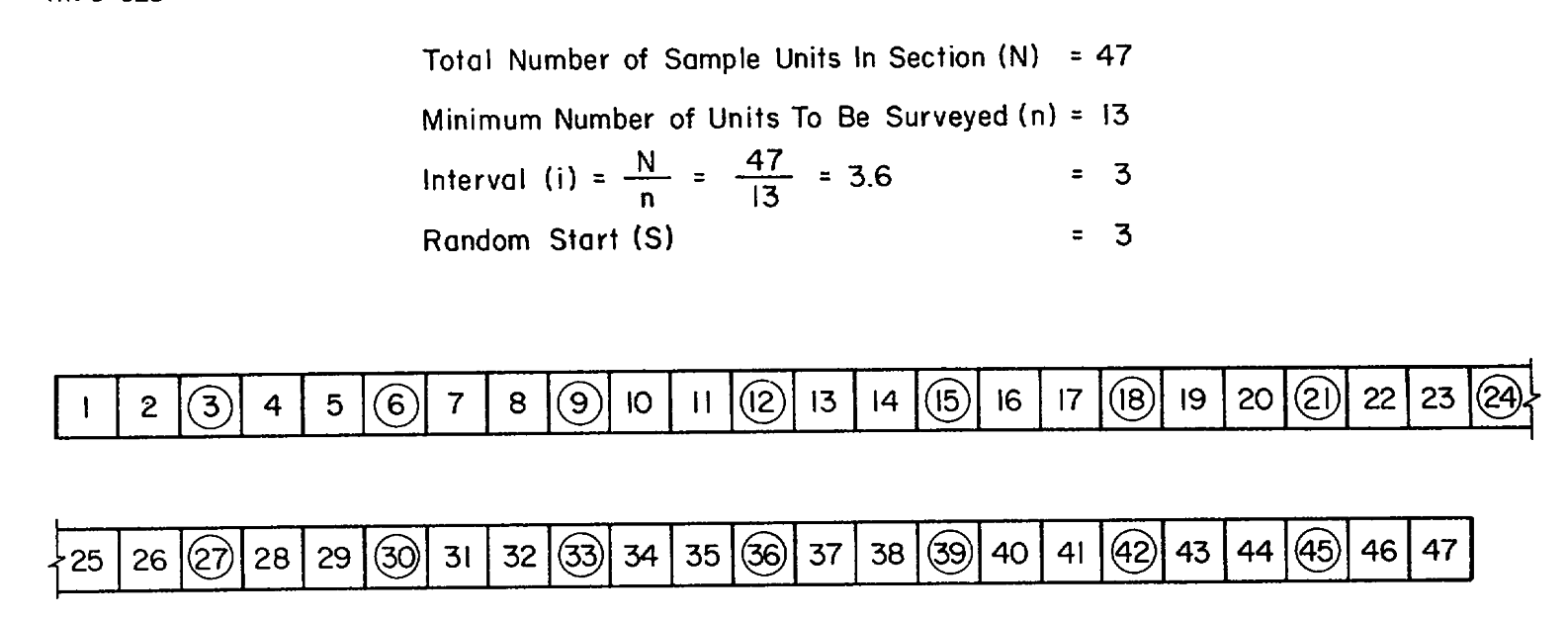
TM 5-623
Figure 3-5. Example selection of sample units to be surveyed.
(1)
The "sampling interval" (i) is determined
was not selected at random and/or contains distress(es)
by i=N/n, where N=total number of available sample
which are not representative of the section.
units, n=minimum number of sample units to be
(2)
The calculation of the PCI when additional
surveyed, and i is rounded off to the smaller whole
sample units are included is slightly altered and its
number (e.g., 3.6 is rounded to 3).
described in paragraph 3-5.
(2)
The random start (s) is selected at random
between 1 and the sampling interval (i). For example, if
3-5. Calculating the PCI from inspection results
i=3, the random start would be a number from 1 to 3.
a. General. Paragraph 3-4 described two ways of (3)
The sample units to be surveyed are
inspecting a pavement section; i.e., inspecting every unit
identified as s, s+i, s+2i, s+3i, etc. If the selected start is
in the section or inspecting by sampling. Data collected
3, then the samples to be surveyed are 3, 6, 9, 12, etc.
during either method of inspection are used to calculate
(See fig 3-5.) This technique is simple to apply and also the PCI. This paragraph explains how to calculate the
gives the information necessary to establish a PCI profile
PCI for a particular sample unit, and how to calculate the
along the pavement section.
PCI for the entire pavement section. An important item
d. Selection of additional sample units. One of the
in the calculation of the PCI is the "deduct value." A
major objections to sampling is the problem of not
deduct value is a number from 0 to 100, with 0 indicating
including very "poor" or "excellent" sample units which
the distress has no impact on pavement condition, and
may exist in a section. Another problem is the selection
100 indicating an extremely serious distress which
of a random sample which contains nontypical distresses
causes the pavement to fail.
such a railroad crossings, potholes, etc.
b. Calculating sample unit PCI. Calculating the PCI
(1)
To overcome these problems, the
for a sample unit is a simple procedure which involves
inspector should label unusual sample units as additional
five steps (see fig 3-6):
sample units. An additional unit implies that the sample
3-6
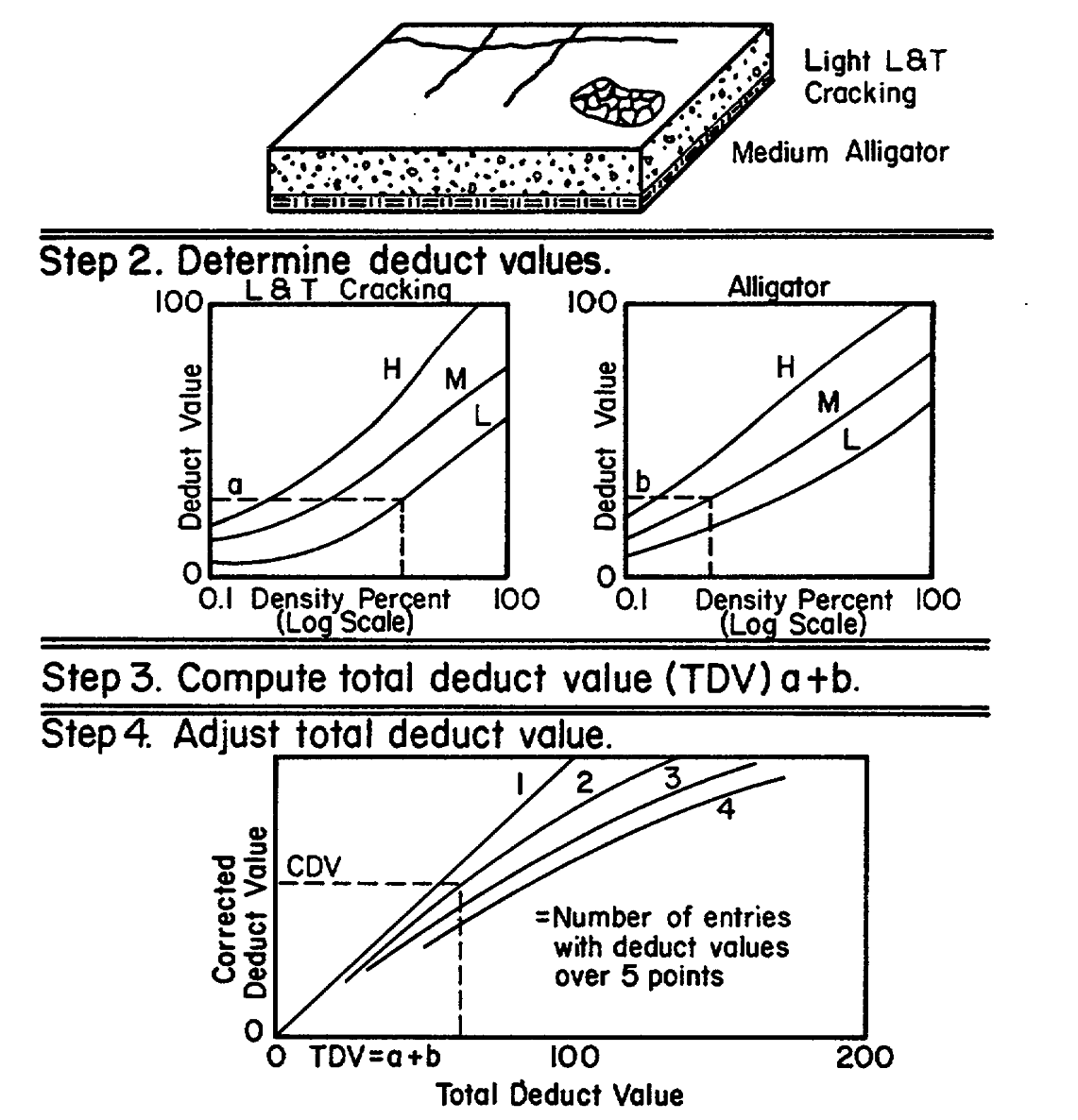
TM 5-623
Step 1. Inspect sample units: Determine distress types
and severity levels and measure density.
Step 5. Compute pavement condition index (PCI) =100 -CDV for each
sample unit inspected
Figure 3-6. Steps for calculating PCI for a sample unit.
(1) Step 1. Each sample unit is inspected and
individual deduct value. For example, assume that two
distress data recorded on DA Form 5145-R for concrete
distresses were found in an asphalt pavement, one with
or DA Form 5146-R for bituminous pavements as
a deduct value of 50, and the other with a deduct value
described in paragraph 3-3. (See figs 3-2 and 3-3.)
of 10. Using figure C-20, the CDV for q=2 (q = number (2) Step 2. The deduct values are determined
of individual deducts whose value is greater than 5) is
from the deduct value curves for each distress type and
44. Since 44 is lower than 50, the CDV is set equal to
severity. (See app C.)
50.
(3) Step 3. A total deduct value (TDV) is
(5) Step 5. The PCI is computed using the
computed by summing all individual deduct values.
relation PCI = 100 CDV.
(4) Step 4. Once the TDV is computed, the
corrected deduct value (CDV) can be determined from
c. Calculating the PCI for a pavement section. If all
the correction curves (fig C-20 or fig C-40). When sample units in a section are surveyed, the PCI of the
determining the CDV, if any individual deduct value is
section is computed by averaging the PCIs
higher than the CDV, the CDV is set equal to the highest
3-7
TM 5-623
of all its sample units. Inspection by sampling, however,
as follows:
requires a different approach. If all surveyed sample
units are selected randomly, the PCI of the pavement
Density =
number of slabs containing a particular type X 100
section is determined by averaging the PCI of its sample
distress number of slabs in sample unit
units. If any additional sample units are inspected, a
weighted average must be used. The weighted average
For example, two slabs in the pavement sample unit
is computed by using the following equation:
shown in figure 3-2 contained linear cracking (distress 28) at medium severity, so the density is calculated as 2
20X 100, or 10 percent. The deduct values are then
PCIs = (N-A)(PCI1 + A)(PCO1) + A(PCO2)
N
(Equation 3-1)
determined for each distress combination from the
distress deduct value curves given in figures C-21
where PCI
through C-39. The CDV is determined from figure C-40,
s = PCI of pavement section, PCI1 = average
PCI of random samples, PCI
and the PCI is calculated as shown in figure 3-2.
2 = average PCI of
additional samples, N = total number of samples in the
e. Determination of distress quantities for a
section, and A = number of additional samples
pavement section. When a pavement has been
inspected.
inspected by sampling, it is necessary to extrapolate the
quantities and densities of distress over the entire
d. Example calculation of the PCI for a sample unit.
pavement section to determine total quantities for the
The field data sheets described in paragraph 3-3 are section.
always used when calculating the PCI of a sample unit.
(1)
If all sample units surveyed were selected
(1) Asphalt pavement inspection sheet (fig 3-
at random, the extrapolated quantity of a given distress
3).
of a given severity level would be determined as
(a) The difference between calculating
illustrated in the following example for medium-severity
a PCI for an asphalt sample unit and calculating a PCI
alligator cracking:
for a concrete sample unit is in the way the distress
density is determined.
Section Information
1. Density for distresses measured by
Surface type: Asphalt concrete
the square foot is calculated as follows:
Area: 24,500 square feet
Total number of sample units in the section: 10
Density =
distress amount in square feet
sample unit area in square feet
X100
Five sample units were surveyed at random, and the
amount of medium-severity alligator cracking was
2. Density for distresses measured by
determined as follows:
the linear foot (bumps, edge cracking, joint reflection
cracking, lane/shoulder drop off, and longitudinal and
Sample
Sample Unit
Medium-Severity Alligator
transverse cracking) is calculated as follows (see
Unit ID
appendix B for distress definitions):
Number
Area, Square Feet
Cracking, Square Feet
02
2500
100
Density =
distress amount in linear feet
04
2500
200
sample unit area in square feet
X100
06
2500
150
3.
Density for distress measured by number (potholes)
08
2500
50
is calculated as follows:
10
2000
100
Total
Density =
number of potholes
Random
12,000
600
sample unit area in square feet
X100
The average density for medium-severity alligator
(b) After the distress density for each distress
cracking is, therefore, 600/12,000 = 05. The
type/severity combination is calculated, the deduct
extrapolated quantity is determined by multiplying the
values are determined from the distress deduct value
density by the section area, i.e., .05X24,500=1225
curves in figures C-1 through C-19 of appendix C. The square feet.
corrected deduct value (CDV) is determined from figure
(2)
If additional sample units were included in
C-20 and is calculated as shown in figure 3-3.
the survey, the extrapolation process would be slightly
(2) Concrete pavement inspection sheet (fig
different. In the example given in (1) above, assume that
3-2). After inspection, calculate the density of distress sample unit number 01 was surveyed as additional and
that the amount of medium-severity alligator cracking
3-8
TM 5-623
was measured as follows:
Since 2500 square feet were surveyed as additional, the
section’s randomly surveyed area is, therefore, 24,500-
Additional
Sample Unit
Medium-Severity
2500=22,000 square feet. The extrapolated distress
Sample Unit ID
Area, Square FeetAlligator
quantity is obtained by multiplying the distress density by
Cracking,
the section’s randomly surveyed area and then adding
Square Feet
the amount of additional distress. In this example:
01
2500
1000
Extrapolated Distress Quantity =.05 x 22,000 + 1000
Total
=2100 square feet
Additional
2500
1000
3-9
TM 5-623
CHAPTER 4
MAINTENANCE AND REPAIR (M&R) GUIDELINES
4-1. Introduction
that can be used to determine whether variation exists.
M&R needs and priorities are highly related to the PCI,
When a PCI value of a sample unit in the section is less
since the PCI is determined by distress information
than the sample unit critical PCI value, a localized
which is a key factor in establishing pavement M&R
random variation exists. For example, if the mean PCI of
requirements. This chapter describes how to do a
a section is 59, any sample unit with a PCI of less than
payment evaluation, how to determine feasible M&R
42 should be identified as a localized bad area by circling
alternatives, and how to establish M&R priorities. These
"Yes" under item 2a on the form. This variation should
guidelines should be based on the PCI, with
be considered when determining M&R needs.
consideration given to other important factors including
Systematic variation occurs whenever a large,
pavement load-carrying capacity. Nondestructive
concentrated area of a section has significantly different
pavement testing techniques may be used in this load-
condition. For example, if traffic is channeled into a
carrying capacity evaluation. A specific M&R alternative
certain portion of a large parking lot, that portion may
can often be selected for a pavement section that is in
show much more distress or be in a poorer condition
very good or excellent condition without a life-cycle cost
than the rest of the area. Whenever a significant amount
analysis. In cases where a life-cycle cost analysis is
of systematic variability exists within a section, the
necessary to select among feasible alternatives, the live-
section should be subdivided into two or more sections.
cycle cost analysis method described in chapter 5 should In that example being considered (fig 4-1) there was no be used.
localized random or systematic variation, so "No" was
circled at both lines 2a and 2b.
4-2. Pavement evaluation procedure
c. Rate of deterioration of condition-PCI. Both the
Evaluation is performed on a section-by-section basis
long and short-term rate of deterioration of each
since each section represents a unit of the pavement
pavement section should be checked. The long-term
network that is uniform in structural composition and
rate is measured from the time of construction or time of
subjected to consistent traffic loadings. It is necessary to
last overall M&R (such as an overlay). The rate is
make a comprehensive evaluation of pavement condition
determined as low, normal, or high using figures 4-3
before rational determination of feasible M&R
through 4-6. The figures are for the following four alternatives can be made. A step-by-step description of
payment types respectively: asphalt concrete (AC)
how to complete the DA Form 5147-R, Section
pavements, AC overlay over AC pavements, Portland
Evaluation Summary (fig. E-3) is given below. An cement concrete (PCC) pavements, and AC overlay over
example of a completed DA Form 5147-R is shown at
PCC pavements. Development of the curves delineating
figure 4-1.
the low, normal, and high rate of deterioration was based
a. Overall condition. The PCI of a pavement
on field data from Fort Eustis, Virginia. For example, an
section describes the section’s overall condition. The
AC pavement that is 20 years old with a PCI of 50 is
PCI, and thus the section condition rating (e.g., good or
considered to have a high long-term rate of deterioration
very good), is based on many field tests and represents
with respect to other AC pavements. Short-term
the collective judgment of experienced pavement
deterioration (i.e., a drop in PCI during the last year)
engineers. In turn, the overall condition of the section
should also be determined since a high short-term
correlates highly with the needed level of M&R. In figure
deterioration rate can indicate the imminent failure of a
4-1 the PCI of the section under consideration was 15, pavement section (fig. 4-7). In general, whenever the so that number was recorded on line 1 and the
PCI of a section decreases by 7 or more PCI points in a
appropriate rating-"very poor"-circled.
year, the deterioration rate should be considered high. If
b. Variations of the PCI within section. PCI
the loss in PCI points is 4 to 6, the short-term
variation within a section can occur on a localized
deterioration rate should be considered normal. It
random basis, and/or a systematic basis. Figure 4-2,
which was developed








